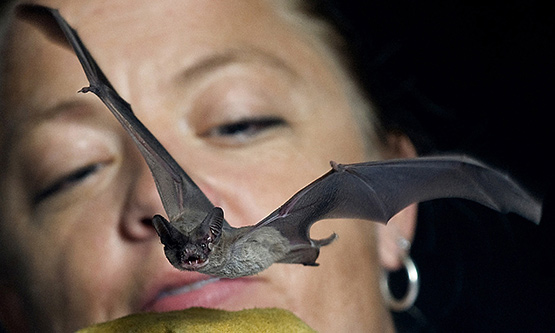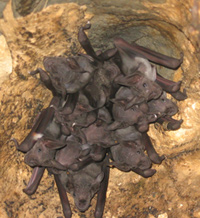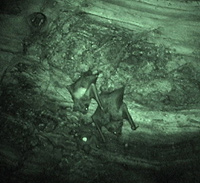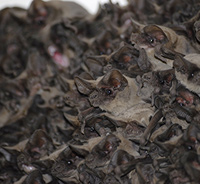Bats shed light on our humanity

A Brazilian free-tailed bat flies in front of Kirsten Bohn. The largest colony in the U.S. lies in Austin, Texas, and it is composed of members of this species of bat, whose males are known for their ultrasonic songs.
Bats form clans, raise their young together, sing songs and – yes – fight amongst themselves, just like us.
 Kirsten Bohn
Kirsten Bohn
by Kirsten Bohn, visiting assistant professor of biology
When people ask what I do, and I say I study behavior and communication in bats, the response is invariably, “BATS!!! Why bats?” Whether the tone is of horror or wonder, there is always a hint that it is the oddest, most obscure thing they’ve ever heard. But, bats are neither rare nor obscure. With more than 1,000 species, one-quarter of all mammals are bats. Bats are found everywhere except Antarctica and eat almost everything imaginable – insects, small animals, blood, nectar or fruit. So why do we have the impression that bats are so rare? They are nocturnal, hide during the day, and to navigate they use sonar that we cannot hear. Because bats are rarely seen or heard and difficult to study, their lives have been a secret.
So bats are not quite as obscure as many think, but back to the question – why bats? The answer lies in all of us. It is a passion for understanding what makes us unique in the biological world – social and vocal complexity. Humans have highly structured societies, and the ways in which humans cooperate is unparalleled in other organisms. Similarly, the syntactic and semantic properties of language also make it a uniquely human trait. However, how language, cooperation and complex societies evolved in humans remains highly controversial. Our best bet to better understand our own evolution is by examining vocal and social complexity in other animals, preferably a close relative, say a mammal. This is where bats come in. Recent technological advances in infrared video and high-speed sound recordings are revealing that bats have exceedingly complex social and vocal behaviors.
Social Complexity
 A cluster of pups cling to a cave ceiling in Trinidad.
A cluster of pups cling to a cave ceiling in Trinidad. Infrared video shows females visiting pups on the wall of a cave. The whites spots are Kirsten’s markings, which she uses to track activity.
Infrared video shows females visiting pups on the wall of a cave. The whites spots are Kirsten’s markings, which she uses to track activity.I spent three years in Guanapo cave, Trinidad. Although knee deep in guano with a full mask respirator and cockroaches the size of mice, I was in heaven with more than 500 greater spear-nosed bats only two feet over my head. These large bats are of particular interest, because they have a unique social structure: females reside in extremely stable social groups. This means you can return to find the same females in the same spot in the cave ceiling night after night, year after year, for up to 15 years. What is most remarkable is that these females are not blood related. These types of long-term associations among non-relatives are common in humans but extremely rare in other animals. Why stick with the same “buddies” in a group? Cooperation!
All of the females in a social group reproduce once a year simultaneously. Like birds, pups cannot fly at birth and we found that pups frequently fall from the ceiling of the cave to the floor. Once a pup has fallen the only way for it to get back to the roost is to get picked up by an adult. Using infrared video and bleach markings on bats we found that once a pup fell, hundreds of adults would fly down to it. Although one female would pick the pup up, what were the others doing?
Using genetic analyses, field observations and perceptual experiments, we found that pups were usually picked up by mothers. Bats from different social groups would attack and sometimes eat pups, while group mates of the pups’ mothers would guard over pups. This is much like a society of warring clans (there are about 25 “clans” in the cave each with 10 to 30 adults). Bats from the same clans cooperate and “help” each other; those from different clans attack each other.
Vocal Complexity
The star of the vocal complexity tale is the Brazilian free-tailed bat. These bats are well known for their huge colonies in Texas, including the country’s largest urban colony in Austin. My research revealed that males sing like birds (albeit ultrasonically). I’ve recorded songs all over Texas and in Mexico and have found that all songs are hierarchically structured with specific syllables used in phrases that are then combined to form songs. The order of phrases follows specific syntactical rules and particular phrase combinations are preferred over others. What is most remarkable about this system, however, is song flexibility. Even though song construction follows basic rules, males dynamically vary syllable number, phrase order and phrase repetitions across song renditions. This type of vocal signal – hierarchical and structured, yet flexible – has until now only been seen in humans, birds and whales, making this a compelling system for exploring how and why complexity and flexibility, fundamental requisites for speech, arose in a mammalian system.
 A migrating colony of free-tailed bats. They live in groups and cram together like sardines.
A migrating colony of free-tailed bats. They live in groups and cram together like sardines.My research experience has many ramifications in and out of the classroom. First, I use science as a tool to understand behavior. Second, as people learn more about the secret lives of bats, they must appreciate that there is an entire biological world out there that is waiting to be discovered; if we continue to destroy our world, we never will make those discoveries. Third, I hope that by finding other organisms with traits that were thought to be uniquely human, people will realize that we are the product of biology and evolution.